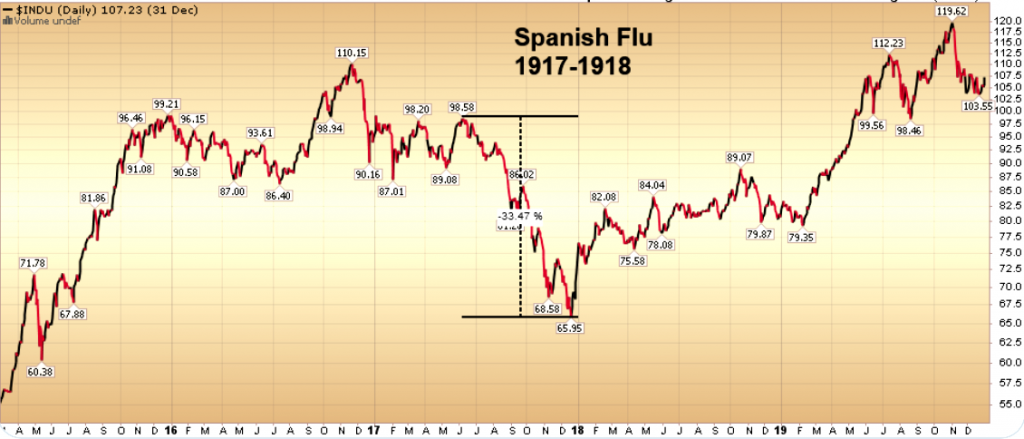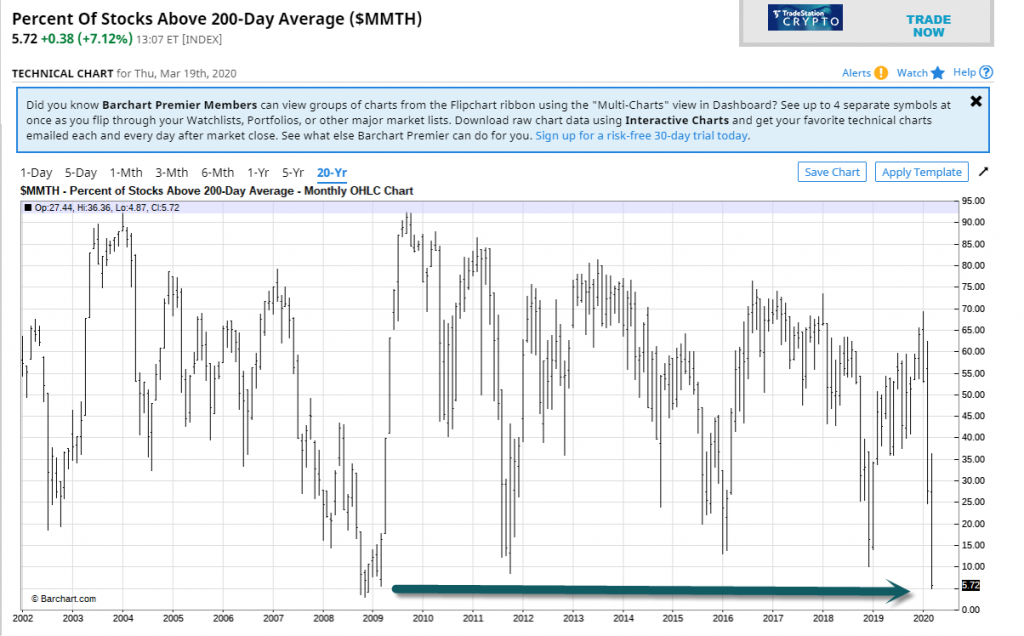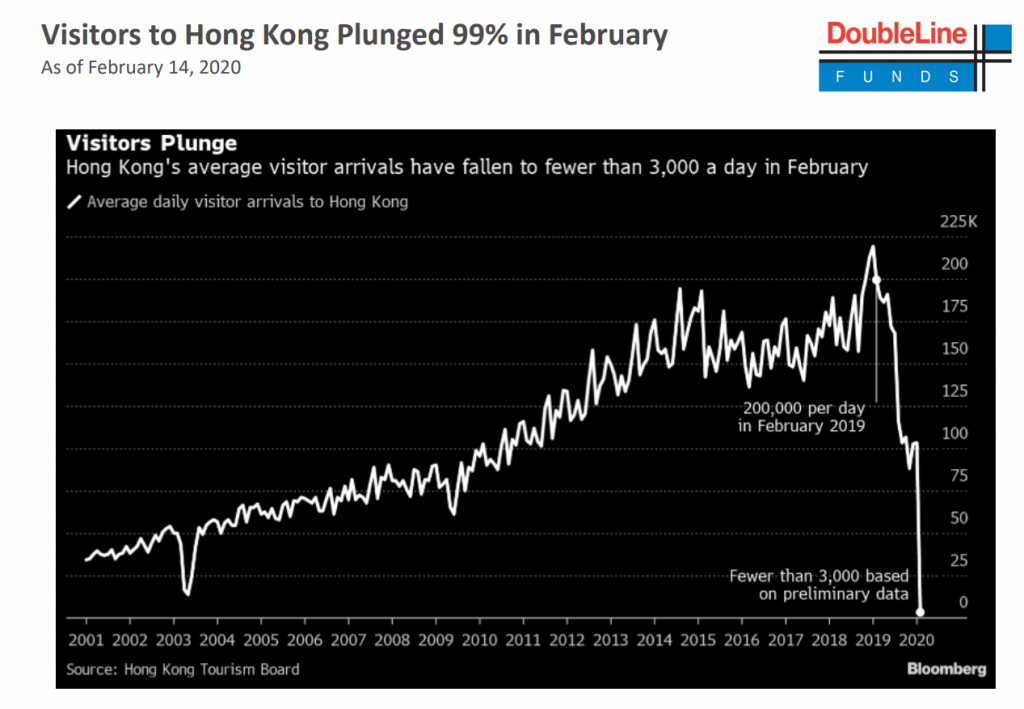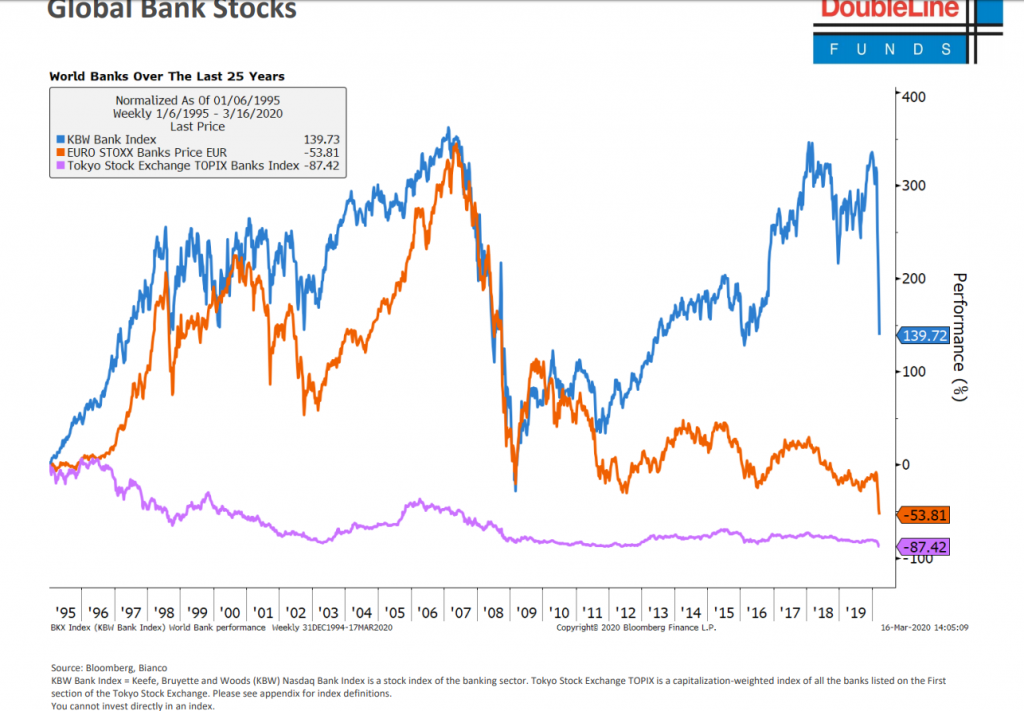1.How The Market Survived the Spanish Flu?
Sell-off lasted 6 months and took DOW 34% lower (-40% from highs set some months before the flu), stocks rallied 25% in less than 2 months following the trough. It took 18 months to erase the flu sell-off.
The corona cycle likely will be faster and swifter because there was not electronics, twitter or texting back then!


Zach Goldberg
Head of Franchise Sales
Office: 212.284.2314
Cell: 240.355.5342
Disclaimer: http://www.jefferies.com/salesandtradingdisclaimer/
2.Percentage of Stocks Above 200-Day Average Hits 2008 Levels.

3.Softbank -51% From Highs.
Softbank poster child for conglomerate spending in expensive market

www.stockcharts.com
SoftBank Group Corp.[5][6] is a Japanese multinational conglomerate holding company headquartered in Tokyo.
The company owns stakes in Softbank Corp. (ja), Softbank Vision Fund (ja), Arm Holdings, Fortress Investment Group, Boston Dynamics, Sprint (85%), Alibaba (29.5%), Yahoo Japan (48.17%), Brightstar (87.1%), Uber (15%), Didi Chuxing (ca.20%), Ola (ca.30%), Renren (42.9%), InMobi (45%), Hike (25.8%), Snapdeal (ca.30%), Fanatics (ca.22%), Improbable Worlds (ca.50%), Paytm (ca.20%), OYO (42%), Ping An Insurance (7.41%)[7], Slack Technologies (ca.5%), WeWork (ca.80%), ZhongAn Online P&C Insurance (5%), Compass (ca.22%), AUTO1 Group (ca.20%), Wag (45%), Katerra (ca.28%), Cruise Automation (ca.19.6%), ParkJockey[8], Tokopedia (Indonesia)[9], and many more companies. It also runs Vision Fund, the world’s largest technology-focused venture capital fund, with over $100 billion in capital.[10][11]
https://en.wikipedia.org/wiki/SoftBank_Group
4.Credit Market Lack of Liquidity Massive Impact on Funds…
Vanguard Tax-Exempt Muni Fund Drops -18%

www.stockcharts.com
Product summary
• Seeks to track the performance of the S&P National AMT-Free Municipal Bond Index.
• Broadly diversified exposure to investment-grade U.S. municipal bond market.
• Passively managed using index sampling.
• Intermediate-duration portfolio.
• Provides moderate current income with high credit quality.
https://investor.vanguard.com/etf/profile/VTEB
Thanks to Don Riley at Wealth Enhancement Group
5.Visitors to Hong Kong -99% in Feb.
From Jeff Gundlach Deck

https://www.advisorperspectives.com/pdfs/2020/Slides/3-17-2020-TR-Presentation-FINAL.pdf
6.Global Bank Stocks Below 90’s Levels.

https://www.advisorperspectives.com/pdfs/2020/Slides/3-17-2020-TR-Presentation-FINAL.pdf
7.The Chance of U.S. Recession in Next 12 Months Now 53%

https://www.bloomberg.com/graphics/us-economic-recession-tracker/
8.Silver Breaks Thru All Levels to Downside….-72% From 2011 Highs.

www.stockcharts.com
9.Timeline: The early days of China’s coronavirus outbreak and cover-up
Bethany Allen-Ebrahimian
Axios has compiled a timeline of the earliest weeks of the coronavirus outbreak in China, highlighting when the cover-up started and ended — and showing how, during that time, the virus already started spreading around the world, including to the United States.
Why it matters: A study published in March indicated that if Chinese authorities had acted three weeks earlier than they did, the number of coronavirus cases could have been reduced by 95% and its geographic spread limited.
This timeline, compiled from information reported by the Wall Street Journal, the Washington Post, the South China Morning Post and other sources, shows that China’s cover-up and the delay in serious measures to contain the virus lasted about three weeks.
Dec. 10: Wei Guixian, one of the earliest known coronavirus patients, starts feeling ill.
Dec. 16: Patient admitted to Wuhan Central Hospital with infection in both lungs but resistant to anti-flu drugs. Staff later learned he worked at a wildlife market connected to the outbreak.
Dec. 27: Wuhan health officials are told that a new coronavirus is causing the illness.
Dec. 30:
• Ai Fen, a top director at Wuhan Central Hospital, posts information on WeChat about the new virus. She was reprimanded for doing so and told not to spread information about it.
• Wuhan doctor Li Wenliang also shares information on WeChat about the new SARS-like virus. He is called in for questioning shortly afterward.
• Wuhan health commission notifies hospitals of a “pneumonia of unclear cause” and orders them to report any related information.
Dec. 31:
• Wuhan health officials confirm 27 cases of illness and close a market they think is related to the virus’ spread.
• China tells the World Health Organization’s China office about the cases of an unknown illness.
Jan. 1: Wuhan Public Security Bureau brings in for questioning eight doctors who had posted information about the illness on WeChat.
• An official at the Hubei Provincial Health Commission orders labs, which had already determined that the novel virus was similar to SARS, to stop testing samples and to destroy existing samples.
Jan. 2: Chinese researchers map the new coronavirus’ complete genetic information. This information is not made public until Jan. 9.
Jan. 7: Xi Jinping becomes involved in the response.
Jan. 9: China announces it has mapped the coronavirus genome.
Jan. 11–17: Important prescheduled CCP meeting held in Wuhan. During that time, the Wuhan Health Commission insists there are no new cases.
Jan. 13: First coronavirus case reported in Thailand, the first known case outside China.
Jan. 15: The patient who becomes the first confirmed U.S. case leaves Wuhan and arrives in the U.S., carrying the coronavirus.
Jan. 18:
• The Wuhan Health Commission announces four new cases.
• Annual Wuhan Lunar New Year banquet. Tens of thousands of people gathered for a potluck.
Jan. 19: Beijing sends epidemiologists to Wuhan.
Jan. 20:
• The first case announced in South Korea.
• Zhong Nanshan, a top Chinese doctor who is helping to coordinate the coronavirus response, announces the virus can be passed between people.
Jan. 21:
• The U.S. Centers for Disease Control and Prevention confirms the first coronavirus case in the United States.
• CCP flagship newspaper People’s Daily mentions the coronavirus epidemic and Xi’s actions to fight it for the first time.
• China’s top political commission in charge of law and order warns that “anyone who deliberately delays and hides the reporting of [virus] cases out of his or her own self-interest will be nailed on the pillar of shame for eternity.”
Jan. 23: Wuhan and three other cities are put on lockdown. Right around this time, approximately 5 million people leave the city without being screened for the illness.
Jan. 24–30: China celebrates the Lunar New Year holiday. Hundreds of millions of people are in transit around the country as they visit relatives.
Jan. 24: China extends the lockdown to cover 36 million people and starts to rapidly build a new hospital in Wuhan. From this point, very strict measures continue to be implemented around the country for the rest of the epidemic.
The bottom line: China is now trying to create a narrative that it’s an example of how to handle this crisis when in fact its early actions led to the virus spreading around the globe.
Go deeper: China’s coronavirus cover-up was among worst in history, congressman says
Editor’s note: This story will be updated as more information is reported.
Sign up for Bethany’s weekly newsletter, Axios China.
https://www.axios.com/timeline-the-early-days-of-chinas-coronavirus-outbreak-and-cover-up-ee65211a-afb6-4641-97b8-353718a5faab.html
10.How to Work from Home Successfully in 7 Steps
Working from home can be amazing, productive, and fulfilling…it can also be crazy-making, full of distractions, and challenging.
I have been working from home for 13 years. And 3 years ago my husband joined me.
I have meticulously kept productivity journals since the start of working from home and have noticed some great patterns that I want to share with you.
I have had certain years where I got TONS done. In 2017 I published a book (yay Captivate), launched a new product (whoop People School) and hired a new team member. And I have had other years (2010 & 2013) where it seemed like nothing happened at all. Why!?
Here are my favorite strategies for how to work from home effectively, productively, and—dare I say—enjoyably. I now LOVE working from home and think it is an incredible option for most people (including extroverts).
The key to working from home successfully is to understand your productivity triggers and to optimize your home life WITH your work life.
With the spread of Coronavirus, cold & flu season, and just the lengthening nature of commutes, you should consider working from home. Here’s how to work from home like a boss:
Step #1: Know Your Triggers
The best thing about working from home is that you have everything you need nearby. The worst thing about working from home is that you have everything you need nearby.
Your desk is super close, but so is your bed. Your commute is super close, but so is your trek to the kitchen. Now is when you have to think about removing triggers.
I want you to take away things that will destroy your productivity:
• Put the TV remotes and/or your iPad in a drawer far away. No joke, I have turned on the TV “just for a minute” during lunch only to have it on in the background for 2 hours.
• If you do not normally work with your cell phone on, put it far, far away.
• Ask your partner or kids or neighbor to lock you out of Netflix or Hulu. It gets very tempting at around 3pm….
• Remove anything that you know distracts you—strip the sheets off your bed if you must.
I want you to add things that will help you be more productive:
• Get a great set of noise-canceling headphones.
• Put a sign on your door that says “Do Not Disturb” or “Leave Packages at Door”
• Put a coffee maker in your bedroom or home office so you can avoid the kitchen entirely (snacks, dishes, kids).
• Put healthy snacks in a drawer in your desk so you do not go wandering for a snack.
• Pre-make your lunches just like you would do at work–pre-made salads and sandwiches do best.
Step #2: Punch In (and let everyone know)
The hardest part about working from home is not having a clear start time or end time, or workspace versus personal space. Typically work and home begin to blend together so you have to WORK at separating the two. This begins with time.
There are some GREAT benefits from working from home like:
• No commute
• No need to pack a lunch
• No make-up / hair (unless you do video calls)
• You could wear your pajamas (more discussion on this later)
• No checking traffic
• No stopping for gas
• No need to park or buy public transport tickets
• No schmoozing with people in the elevator
But there are also some downsides to working from home:
• No colleagues to say hello to (this could be a benefit if you are an introvert)
• No designated office space
• Kids, spouse, pets as distractions
• Laundry, dishes, errands as distractions
• TV, iPad, bed as distractions
• No office snacks (if you are lucky enough to have this at work!)
• No office coffee bar (if you are lucky enough to have this at work!)
The best way to combat the downsides and increase the upsides is to create an official start time to your work day at home.
Do not take this step lightly. Take into account:
• Your morning chores
• Potential distractions in the house like pets or kids or roommates
• Your new at-home, get ready routine (no suit? no makeup?)
• Your new timeline
Then remove tasks that disappear from your work day now:
• No commute
• Easier to get ready
• No packing a lunch
What time should your start time be? For example, your old routine might look like this:
7:00 a.m. — Wake-up, shower, make-up, get dressed
7:30 a.m. — Get kids ready + breakfast
8:00 a.m. — Out the door
9:00 a.m. — At desk
Your new routine could change to:
7:00 a.m. — Wake-up, shower
7:30 a.m. — Get kids ready
7:45 a.m. — Start laundry + do dishes
8:00 a.m. — Turn on Computer
In other words, your extra time allows you to do some extra household chores before you start. And maybe you start an hour early so you can finish an hour early when the kids get home.
You want to create a new start time accounting for old tasks you no longer have to do and new tasks you now have time to do.
My new start time is: ____
Once you pick your new start time, make it known! Everyone in your home should know this, whether they will be home or not. If people are home, tell everyone:
“I’m starting work now. Bye!”
Your official start time is sacred; it will set-up your entire day.
Step #3: Work Your Rhythms
You have a wonderful opportunity if you work from home. You can re-evaluate your most optimal schedule. When I reviewed the science of productivity I learned that everyone has different rhythms. The time at which you choose to perform a task is incredibly important. Not all times are created equal. Think about your typical daily and weekly tasks, and make a basic list. This might be:
• Emails
• Researching
• Team Calls
• Writing
• Paperwork
Now think about when you do best at these tasks. For example, I used to do all of my email first thing in the morning. Then I found this fascinating research. In Sex Sleep Eat Drink Dream: A Day in the Life of Your Body, Jennifer Ackerman explains that the hormones we need to feel productive are released based on circadian rhythms—natural cycles our bodies go through to carry out daily functions.
Her research shows that our brains are most alert 2.5 – 4 hours after waking up.
This is the time of day that your body releases the most brain power hormones to help you to solve problems, generate ideas and plow through meticulous work.
I was wasting all this good juice! I was most fresh in the morning, and didn’t really need that energy for silly emails. I was much better off spending my tired afternoons corralling emails and putting my morning juice into writing and strategizing.
• Look at your tasks and assign them ideal times. You also might think about what day of the week is best. For example, I find team meetings on Monday are not nearly as productive because not enough of the week has happened to review. After you have broken down tasks and times, begin shuffling your schedule to accommodate.
• A fun tool called Inbox Pause can help prevent distraction by temporarily keeping incoming emails from reaching your inbox!
• The morning is also a good time to brainstorm with teams. There’s a crazy phenomenon called the “morning morality effect” where research has shown that a person tends to have strong moral awareness and self-control in the morning, but this decreases as the day goes on. This is thought to happen because our capacity for self-control can start deteriorating throughout the day as we make more and more decisions. With this being said, try to make all ethical and strategic judgments with your team and colleagues in the morning, while everyone’s mind and moral awareness is heightened.
• Consider scheduling in your breaks. At home, it is easy to wander to the kitchen…the couch…the bedroom at any time. If you find yourself taking more breaks at home, schedule them in.
Step #4: Don’t Be Silly
Whenever I hear advice for people working from home, they seem to remove all the benefits for no good reason. Have you ever heard…
“Get dressed like you are going to work.”
Why?! Unless it makes you feel more productive, why would you waste all that time getting dressed and then having even more dry cleaning, laundry, ironing etc? Wear what will make you most productive! For me that’s yoga pants, slippers and a comfy blouse that is still nice enough for video calls. Boom! PJs on the bottom, work-ready on top!
So instead, dress to be productive. Whatever that means to you.
Step #5: Make a Work Palace
I am a big fan of LOVING your work space. Even if it is a small side counter in the kitchen, you can make it awesome. I call this your work palace. It should make you feel the 3 Ps:
• Proud
• Productive
• Professional
What does your workspace say about you? There is actual research on snooping that found your workspace says a lot about your personality (see step #6). Here are my work from home must-haves:
• A Mega-Large Water Bottle — Less need to keep getting up to go to the kitchen.
• Amazing Headphones — noise canceling, yes please.
• Something Inspiring — I have a Harry Potter wand at my desk. I wave it at the computer when I get a bad email and I swear it helps. I also have a cute bamboo plant which reminds me to breathe.
• A Headset — for video calls or phone calls.
• Post-It Notes — Always have these by your desk — they help you remember the little things and stay on task.
• Gum — Did you know that gum has been proven to boost productivity? Don’t tell your dentist, but it’s true!
Step #6: Leverage Your Extroversion
If you are an introvert working from home – congratulations! You have struck gold.
If you are an extrovert working from home – it will be ok! I can help.
If you are an ambivert working from home – this could be good. Let’s work it out.
Many people do not realize how much working from home will impact their social life, feelings of connectivity, and belonging.
If you are an ambivert or extrovert then you need to be prepared to ensure you get enough social time.
• Book times with friends after work.
• Do happy hour with work colleagues. Even though you are not in the same office you can still get together!
• Join a sports team, take an art class, learn a new skill.
• Do family dinners.
• Make friends as adults — 5 non-awkward steps = )
By the way, according to research everyone has 5 main personality traits and you can be high, medium, or low on each trait. I cover each of these in-depth in my book, Captivate: The Science of Succeeding with People.
A quick overview of each personality trait:
- Extroversion: How much you like being around people and how outgoing you are.
- Openness: How curious and open to new experiences you are.
- Conscientiousness: How organized and detail-oriented you are.
- Agreeableness: How much you like working on a team and how easily you say yes.
- Neuroticism: How much you worry and how emotionally stable you are.
Working from home means you can be flexible and can be optimized to suit your strengths and weaknesses. Looking at personality science when working from home is extremely useful. We already talked about extroversion, but you can also optimize for the others.
For example:
• If you are high in conscientiousness then you are very organized and detail-oriented. You should make sure to keep your workspace sacred (see Step #5).
• If you are low in conscientiousness then you should make sure to bring in tools to help you stay organized — wall calendars, productivity planners, post-it notes & a hyper-organized best friend.
• If you are high in openness then you should order in a new place for lunch every day, or try a new playlist every day while you work.
• If you are low in openness you should pick your favorite meals and place pre-orders, and create your go-to work playlist that auto-starts every day.
Step #7: Punch Out
Make a clear start to your work day AND make a clear end to your at-home work day. This is critical for work-life happiness. When working from home it is very easy to have your work creep into family time and personal time. Make a clear end time and actually punch out.
• Shut down your computer.
• Turn off your desk light.
• Silence your work emails.
This is mostly symbolic, but will also ensure you do not hear a dreaded ping from the other room. And just like the start bell, tell your family, roommates, partner, cats when you are done for the day so they can help keep you accountable.
Many of these steps might involve someone you live with. Be sure to send them this article, have a house meeting, and get buy-in. How can they help you work more productively from home? How can you help them more now that you are home?
I love working from home, but you have to work to make it work for you.
You’ve got this!
You might also like:
Van Edwards
https://www.scienceofpeople.com/work-from-home/